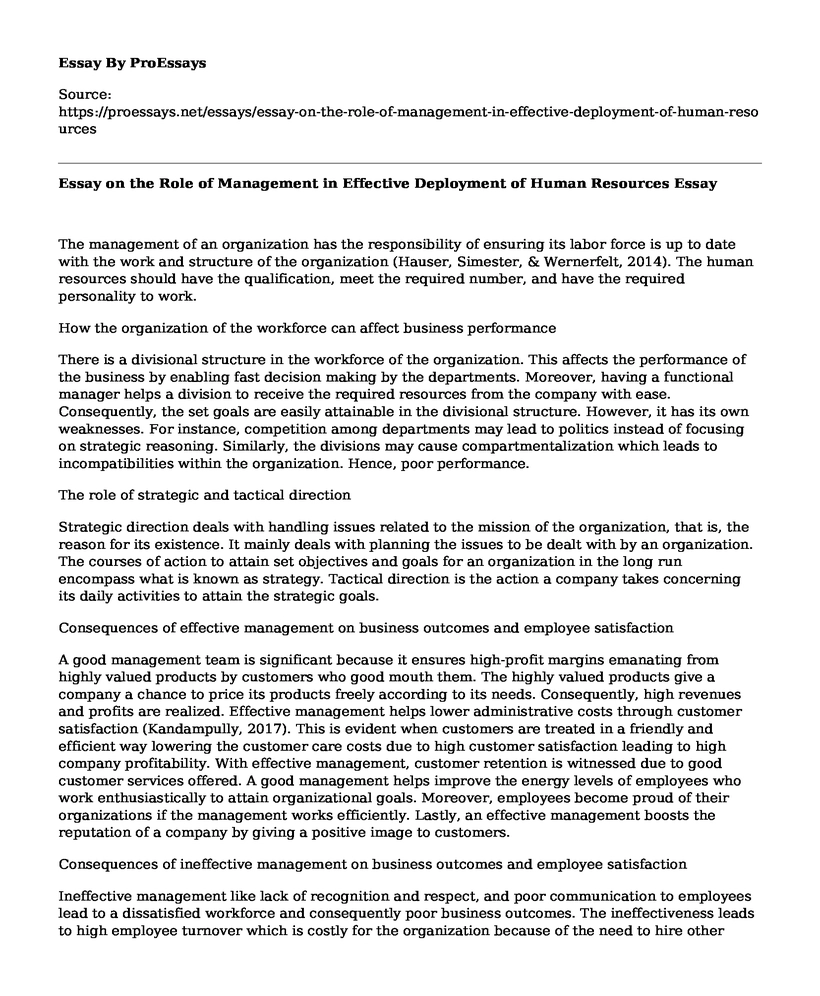The management of an organization has the responsibility of ensuring its labor force is up to date with the work and structure of the organization (Hauser, Simester, & Wernerfelt, 2014). The human resources should have the qualification, meet the required number, and have the required personality to work.
How the organization of the workforce can affect business performance
There is a divisional structure in the workforce of the organization. This affects the performance of the business by enabling fast decision making by the departments. Moreover, having a functional manager helps a division to receive the required resources from the company with ease. Consequently, the set goals are easily attainable in the divisional structure. However, it has its own weaknesses. For instance, competition among departments may lead to politics instead of focusing on strategic reasoning. Similarly, the divisions may cause compartmentalization which leads to incompatibilities within the organization. Hence, poor performance.
The role of strategic and tactical direction
Strategic direction deals with handling issues related to the mission of the organization, that is, the reason for its existence. It mainly deals with planning the issues to be dealt with by an organization. The courses of action to attain set objectives and goals for an organization in the long run encompass what is known as strategy. Tactical direction is the action a company takes concerning its daily activities to attain the strategic goals.
Consequences of effective management on business outcomes and employee satisfaction
A good management team is significant because it ensures high-profit margins emanating from highly valued products by customers who good mouth them. The highly valued products give a company a chance to price its products freely according to its needs. Consequently, high revenues and profits are realized. Effective management helps lower administrative costs through customer satisfaction (Kandampully, 2017). This is evident when customers are treated in a friendly and efficient way lowering the customer care costs due to high customer satisfaction leading to high company profitability. With effective management, customer retention is witnessed due to good customer services offered. A good management helps improve the energy levels of employees who work enthusiastically to attain organizational goals. Moreover, employees become proud of their organizations if the management works efficiently. Lastly, an effective management boosts the reputation of a company by giving a positive image to customers.
Consequences of ineffective management on business outcomes and employee satisfaction
Ineffective management like lack of recognition and respect, and poor communication to employees lead to a dissatisfied workforce and consequently poor business outcomes. The ineffectiveness leads to high employee turnover which is costly for the organization because of the need to hire other people. Absenteeism increases due to poor leadership leading to low productivity (Saari & Judge, 2017).
Recommendations for improving business outcomes and employee satisfaction
Employee satisfaction leads to improved business outcomes. Therefore, to perform well, the management should ensure that the employees are treated respectfully for them to work well and give the customers the needed satisfaction. The employees should be given a fair remuneration and compensation. To ensure an employee is satisfied, job security should also be assured. Finally, business outcomes can be improved by keeping abreast with any industrial developments to ensure effective competition.
References
Hauser, J., Simester, D., & Wernerfelt, B. (2014). Marketing Science: INFORMS. Pubsonline.informs.org. Retrieved 9 March 2017, from http://pubsonline.informs.org/doi/abs/10.1287/mksc.13.4.327
Kandampully, J. (2017). Customer loyalty in the industry: the role of image and customer satisfaction International Journal of Contemporary Hospitality Management: Vol 12, No 6. Emeraldinsight.com. Retrieved 9 March 2017, from http://www.emeraldinsight.com/doi/abs/10.1108/09596110010342559
Saari, L. & Judge, T. (2017). Employee attitudes and job satisfaction. Retrieved 9 March 2017, from http://onlinelibrary.wiley.com/doi/10.1002/hrm.20032/full
Cite this page
Essay on the Role of Management in Effective Deployment of Human Resources. (2021, Apr 12). Retrieved from https://proessays.net/essays/essay-on-the-role-of-management-in-effective-deployment-of-human-resources
If you are the original author of this essay and no longer wish to have it published on the ProEssays website, please click below to request its removal:
- Strategic Communication Plans Analysis
- The Strategic Plan of the Tekno Electricals Company. Essay Sample.
- Essay on Management: Leadership and Management in Professional Contexts
- Essay Sample on Job Satisfaction & Intention to Turn Over: Not Perfectly Related
- Paper Example on Bradley Furniture Inc: Threats Amidst Growth & Financial Losses
- Paper Example on HR: Maximizing Organizations' Success Through People
- Free Essay Sample: Compare and Contrast between Followership and Servant Leadership







